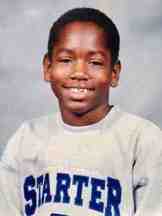PA Troopers Found Liable for Killing 12 Year Old Black Boy Want New Trial
/
Calling a $28 million jury award "shocking" and "the product of passion and prejudice," the attorney for two state police troopers asked that a federal judge set aside the verdict and order a new trial.
Attorney Andrew Fletcher, who represented Cpl. Juan Curry and Trooper Samuel Nassan in the civil suit brought by the father of Michael Ellerbe, argued that attorney Geoffrey Fieger disregarded rules throughout the trial. Fletcher also argued that U.S. District Court Judge Joy Flowers Conti improperly stopped him from admitting evidence that would have let jurors see a clearer picture of what happened when Ellerbe was shot and killed on Dec. 24, 2002.
Last month, a panel of federal jurors awarded Ellerbe's father, Michael Hickenbottom over $28 million in damages in his son's death. The panel found that both Curry and Nassan intentionally shot at Ellerbe, and used excessive force.
Police meanwhile, testified Curry's gun accidentally discharged as he jumped over a fence to chase Ellerbe. The 12-year-old fled from police after crashing a stolen SUV in Uniontown's East End.
When Curry's gun went off, Nassan fired a shot at Ellerbe, killing him.
Nassan told jurors he did so because he believed Curry had been shot. He said he drew that conclusion because he heard the gun discharge, and watched Curry fall. Nassan said he also believed that to be true because Ellerbe was running with his hand in his pocket, refusing repeated commands to remove it. Nassan said he believed that Ellerbe might have had weapon in his pocket.
But Fieger argued that police covered up what truly happened, and banded together to protect Curry and Nassan - a claim that Fletcher contended had already been dismissed before the trial.
Fletcher argued that Fieger, a flamboyant Michigan attorney, did not address evidence related to Nassan and Curry, but put the state police as a whole on trial.
Fieger "scoffed at the notion that he needed to prove anything, even telling the jury in his closing argument that the defendants had the burden of proof.
"This strategy sought to focus the jury solely on the emotion associated with the tragedy that a 12-year-old boy had been shot dead by a police officer, and then to put the Pennsylvania State Police on trial for conspiracy," Fletcher wrote.
Fletcher cited several other court opinions that have overturned cases based on Fieger's courtroom antics.
"(Fieger) has a tried-and-true formula that gives him the results he seeks, without regard to any rules," Fletcher wrote.
He noted that Fieger based his argument on there being a state police cover-up - a claim that Conti dismissed before the trial started. In arguing that there was a cover-up, Fieger made "scurrilous and unsubstantiated allegations," Fletcher contended.
Fieger's other trial strategy was to allege that Curry and Nassan were self-serving, painted against the "portrait of the sainted victim, Michael Ellerbe."
The filing noted that despite Fletcher's objections, Conti barred him from questioning witnesses about Ellerbe's "well-documented history of disciplinary and behavioral problem," while allowing Fieger to show a video of Ellerbe performing in a Christmas pageant days before his death.
That image was furthered when Hickenbottom testified, and painted a warm picture of Ellerbe. That picture did not include the troubles that Ellerbe bad at home, in school or with the law, Fletcher said.
Testimony about those things "would have highlighted the concerns that Nassan and Curry had regarding Michael Ellerbe's dangerousness.
"These records show that Michael Ellerbe destroyed other's property, ran away for days at a time, lacked interest in school, showed disrespect toward authority figures, did not listen, was defiant, kept dangerous weapons in his room, had poor grades and had previously stolen a motorcycle," Fletcher wrote.
Because Fieger was able to offer testimony of Ellerbe's good character, Fletcher argued that he should have been able to present a contrasting view.
Fletcher acknowledged that the death of a 12-year-old evokes a strong, emotional reaction, but said that Fieger exploited that by painted Ellerbe as a "sainted" child.
Conti also should allowed evidence of other investigations, Fletcher argued. Not seeing those things left the jury with the impression that the state police criminal investigation was not subject to an independent review.
So while Fieger was free to criticize the state police investigation, "defendants were systematically precluded from presenting evidence which proved that this investigation was subjected to review and analysis by an independent jury, two separate, experienced and independent prosecutors and by the FBI," Fletcher wrote.
The filing also argues that there was no evidence that Curry intentionally shot Ellerbe, and asks that the judgment against him be dismissed.
Curry testified that he did not intend to fire his gun, and that it went off accidentally. Expert witnesses back up that the gun could have discharged as Curry went over the fence, Fletcher noted.
Fletcher argued that Fieger presented the case as though it was brought against the state police as a whole - and not Curry and Nassan. The punitive damages prove that point, he argued, because the jury levied $12 million in punitive damages against each of the men - even though only Nassan fired the fatal shot.
The $4 million awarded for pain and suffering exceeds the proper amount of damages for the two minutes Ellerbe lived after he was shot, Fletcher argued. He said that the $24 million in punitive damages was meant to punish the state police - not Curry and Nassan.
Fletcher asked that the award amount be reduced. [MORE]












































































































































































































































































